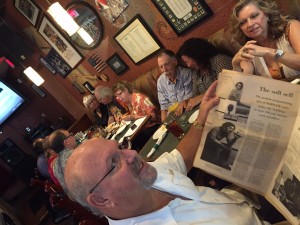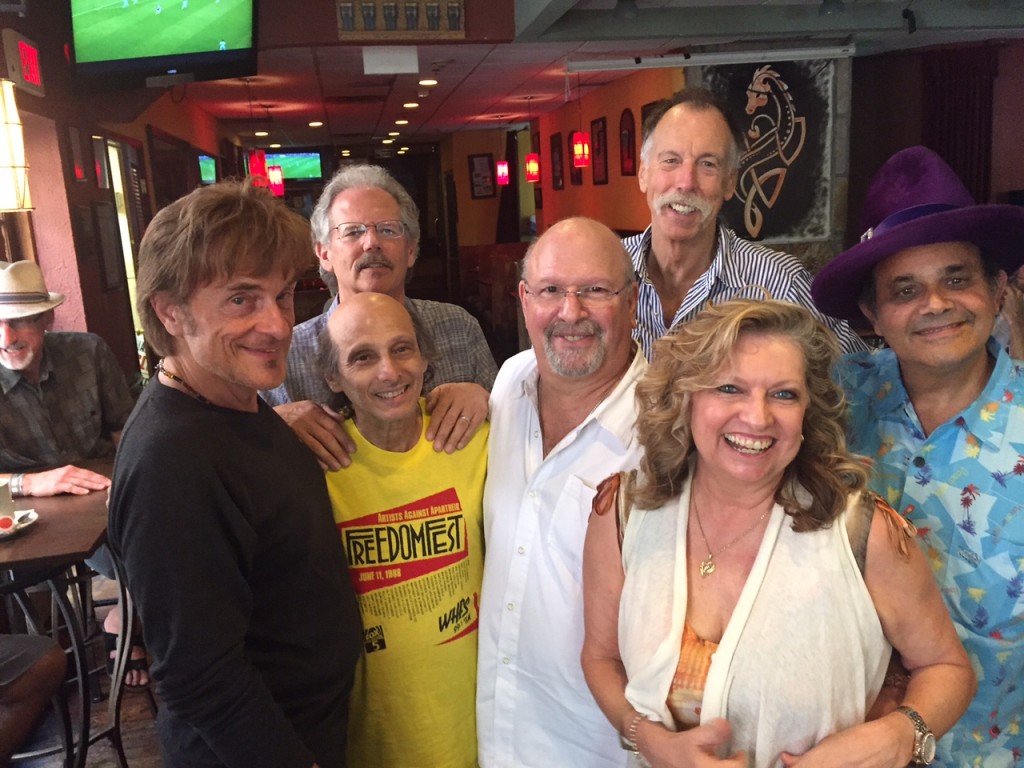In either late 1968 or early 1969, I can’t remember exactly when, Thru the Looking Glass became the second progressive rock show to broadcast from a small unknown station in Bethesda, Maryland. Not in my wildest dreams would I ever imagine blogging about this unique piece of cult radio history 47 years later.
I was a 21 year old Junior at American University doing a pre-recorded progressive rock show with my college roommate, Marc Fleisher on WAMU AM for a couple of hours a week when circumstances and the right contacts landed us on Cordell Avenue on the second floor of Triangle Towers.
I vividly remember the first night we were on the air, Jake had just fired Frank Richards or Frank quit, and Thru the Looking Glass was about to replace DC’s founding father of progressive rock radio. I was excited and nervous and could never have imagined the impact this new rock format and this little station would have on to the entire Washington, DC area.
Frank Richards had a very loyal following. His fans were pissed that he was off the air and the phone calls to the station reflected it. Trying to make a positive first impression, the first show was 4 hours of commercial free music, with the only interruptions for the station ID’s. It was not a very warm welcoming reception for an opening night! But by the end of the first week we had them converted. Nationally, underground radio was only a year or two old. Progressive rock music was exploding, AM radio was only playing songs of three minutes or less and the AM DJ’s were loud and fast talking. We were doing something brand new on WHFS and it was exciting.
Playing long sets of tunes was typically how the show was programmed. I would play 6, 7 or 8 songs in a row depending on the theme for that set of songs and the number of commercial spots that had to run that hour. Since the show ran from 8 – midnight on weekdays I always envisioned my audience as actually listening to the program, not just having it on as background noise. I imagined them listening in candle light or black lights, maybe listening with headphones while they rolled another one!
The great thing about programing your own show is having the ability to play a side of an album, in its entirety, without commercial interruption. Discovering new groups and different musical genre’s was a blast. WHFS gave you the creative freedom to play it all.

Fred Sirkey talks with a fan during brunch at the old Psychy Delly, now Flanagan’s Harp and Fiddle, in Bethesda, MD
Since commercial spots were the mood breaker it was important to have the ads be as least intrusive as possible. This was underground radio but it still was commercial radio. So we would write and produce the spots ourselves in a small production studio next to the announcer’s booth. WHFS gave us the freedom to experiment and try new things. Just don’t get the station in trouble with the FCC and don’t bounce the check that pays our bill for the airtime we rented from them.
Purchasing commercial airtime on a small radio station was pretty inexpensive back then and our audience was a narrow demographic. Lester Grossman and his company LG Productions paid for the block of airtime from 8 – midnight and then we would sell spots on the program to local companies. I think a thirty second commercial was only 6 or 7 dollars. But then a ticket to Woodstock was $7.50 for the day!
LG Productions produced dozens of shows in the DC area including the Who/ Led Zeppelin Concert at Merriweather Post, Steve Miller, Buddy Guy, Procol Harum, & Canned Heat to name just a few.
The music also changed how we looked, and an entire fashion industry was created to reflect the freedom we felt. The Washington area had several clothing entrepreneurs and WHFS was the right place for them to advertise..…how many of you remember: The Sixth Sense in College Park, Hang Ups in Falls Church, The Jean Jack in Bethesda, Until Further Notice, Up Against the Wall, Elysian Fields and Georgetown Leather Design? How about Apple Pie? Record stores like Orpheus Records, orr Music venues like Emergency, The Crazy Horse, and of course, The Cellar Door and The Childe Harold?
I was fortunate to have a unique historical perspective only a handful of people can relate to both in the evolution of WHFS and of this very unique period of music history. Music was the force that brought it together. The singer/songwriters and musicians of the 60’s were able to articulate the feelings of an entire generation. I was a 21 year old college junior and we were going to change the world. I played a part of it through the music I selected to play. WHFS gave us complete creative freedom to do that.
Back then rock music ended at midnight. The all night MOR jock that followed was a nice lady named Camille Bohannon. She did have a great voice for the overnight shift. I can still hear her segue from my last set of rock tunes to the music of Mitch Miller, Burt Kaempfert, and Al Martino. But that was WHFS. Washington High Fidelity Stereo from beautiful downtown Bethesda, Maryland.
Back in 1968 and 1969 WHFS didn’t have progressive rock record library. Nightly I had to carry 50 -75 albums, from my own collection to the station. New bands were forming all the time. The amount of new music I was exposed to was remarkable. The main record distributors at the time were Schwartz Brothers and Jos A. Zamoski. Their PR guys didn’t make stops at WHFS yet, but they would let us come by their building and pick up promo copies of the week’s new releases. My personal record collection was what I used to program each day’s show. Free albums and free concert tickets were two great perks of the job.
I will never forget the night I had two Rastafarian’s at the station. They brought me an early Wailers album to play. I decided to put them on the air and spend maybe thirty minutes talking about their lifestyle in Jamaica. After I got canned from WHFS my first stop, in the spring of 1970, was a visit to Negril.
Sincerely,
Fred Sirkey
P.S. Here’s a recent photo taken at the old Psychy Delly, now Flanagan’s Harp and Fiddle, in Bethesda, Maryland, with the HFS crew and my wife Deborah. I hope to see you at the Feast Your Ears: The Story of WHFS 102.3 documentary Kickstarter Party on Saturday, September 19, 2015 at Villain and Saint in Bethesda. Limited space, so look out for the ticket sales announcement via Feast Your Ears Facebook, Twitter and email post soon!




Used to leave my cassette recorder on at night so I wouldn’t miss anything.
Hi Larry, do you still have any recordings of old HFS shows in your possession? Would appreciate getting in contact if you do!
I grew up with the baby boomers listening to WHFS in the mid/late 60’s. I had three older siblings that steered me your way and I loved it. I met Cerphe a few times and had several conversations about his private collection.
My favorite one was when he told me about introducing Little Feat (when they recorded Waiting for Columbus) and when he led us in spelling out the groups name before they came on stage….great times that I’ve got to share with my kids.
I remember two radio stations from that time…when WGTB would start to fade, turn the dial to WHFs…‘where good times begin’ was always my first choice…I was so glad ther were two progressive radio radio stations in/near the District
What ever happened to the late night DJ named Howard…great voice and music?